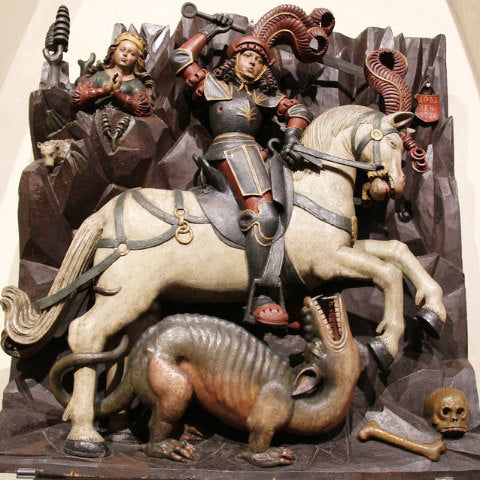Yesterday, the 23rd of April, was the Feast of St. George. It is the traditional day that St George is said to have died a martyr in the year 303, 1720 years ago. He was said to have been a Roman soldier who was persecuted for being a christian. It is also the day usually used to celebrate William Shakespeare’s birth and the anniversary of his death in 1616.

St. George's Day
St. George, by tradition, is said to have been Greek. He is first venerated in the region of Syria Palaestina as he is thought to have been from Lydda.

Many religious traditions honor him and he is first mentioned in Great Briton by the Venerable Bede in the early 8th century. His connection to everything English has ebb and flowed over the years. He became very popular in many areas but during the crusades as a warrior saint. Richard I asked for Saint George to protect his efforts in the 3rd Crusade and the soldiers used the red cross on white field as their badge. In the 14th C Edward III declared Saint George to be the patron of England and connected his Order of the Garter with the Saint. This enhanced his use as a symbol of knight hood and England. Oh, he is also known for killing a dragon to save a princess from being sacrificed. He declined the riches offered in return and is said to have given them to the people, thus inspiring them to convert and be baptized.

The many depictions of him in art over the centuries has inspired many makers of armor and weapons today. He is often seen burying a lance in a dragon from horse back but many examples show him delivering a fatal blow to the beast with an ornate sword.

St George in Stockholm
Using his representation over time to do a study of the development of high-end armor and weapons over time, similar to our review of St. Martin, can give you an idea of the high status items of each period and what great artists saw as the pinnacle of the armorers art. Take for example the elegant saintly sword pictured above about to cleave the worm in a statue in Stockholm.


Shakespeare's Birth & Death
Our interaction with the plays of Shakespeare have been from the earliest making of weapons and armor in our shop. Some of our first customers were performers. We have done several major shows over the years and created some memorable moments for audiences. One of our first big productions was creating multiple suits of armor and weapons for Richard III at the Guthrie Theatre in Minneapolis. The resulting battle on stage was epic.
One of our proudest accomplishments was creating the core of the armory for the new Globe Theatre when it was created in London. The company requested an excellent cross section of Elizabethan swords and weapons to create the plays as they would have been seen by the people of that day. This was a major undertaking and allowed us to create the great wheel of rapiers seen below.

Shakespeare also played a role in enhancing St. George with his epic line from Henry V - Follow your spirit, and upon this charge Cry 'God for Harry, England, and Saint George!
So to all our friends, let us raise a glass to honor the Bard on his day, keep toasts short please, and a Happy St. George's Day to all!

Nathan Clough, Ph.D. is Vice President of Arms and Armor and a member of the governing board of The Oakeshott Institute. He is a historical martial artist and a former university professor of cultural geography. He has given presentations on historical arms at events including Longpoint and Combatcon, and presented scholarly papers at, among others, The International Congress on Medieval Studies.
Craig Johnson is the Production Manager of Arms and Armor and Secretary of The Oakeshott Institute. He has taught and published on the history of arms, armor and western martial arts for over 30 years. He has lectured at several schools and Universities, WMAW, HEMAC, 4W, and ICMS at Kalamazoo. His experiences include iron smelting, jousting, theatrical combat instruction and choreography, historical research, European martial arts and crafting weapons and armor since 1985




